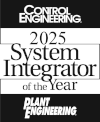Challenge
Acting as the brain behind industrial operations, PLCs are designed to perform logical decision making for control applications. But, what should be done when a PLC system reaches the end of its life cycle? This case study explores how E Tech Group supported the PLC upgrade for a carbon fiber manufacturer. The customer faced the challenge of modernizing their outdated control system which included control panels operating with an Allen-Bradley PLC-5 controller and other legacy hardware. This system was used to control their traction drive process which included VFD controls for multiple motors. The customer wanted to improve their process by upgrading their control, visualization, and machine safety systems, and sought E Tech Group’s expertise to navigate the complexities of this upgrade and seamlessly transform their outdated system with a modern solution.
Solution
E Tech Group designed a plan that fulfilled the customer’s specific requirements and adhered to a tight completion timeline. The customer needed upgraded control panels with new PLC, HMI, and VFD components, alongside a modernization of their existing machine safety system to align with the latest industry standards. The project team carefully assessed each system slated for enhancement, gaining a comprehensive understanding of the customer’s existing system and their other production lines. This supported the factory acceptance testing phase, ensuring the components and controls worked properly according to the functionality of the equipment.
With proof of functionality, quality and integrity in place, the project team swiftly deployed the required upgrades which included build-to-print control panels, an Allen-Bradley PLC-5 to Rockwell Automation Compact GuardLogix controller migration, POINT Guard safety-rated I/O module configuration, Panel View Plus programming, and PowerFlex AC Drives to improve the system’s flexibility and performance.
Results
The project was successfully completed in less than 90 days, with two months dedicated to development and two weeks allocated for commissioning. E Tech Group utilized the expertise of multiple control engineering experts for this project, and effectively leveraged their experience to meet the customer’s tight completion timeline. As a result of the upgraded system, the customer experienced substantial enhancements in productivity, increased reliability, simplified system maintenance, and a user-friendly interface. The project not only met the customer’s requirements but also delivered tangible benefits to improve overall operations.
Challenge
Fires are a devastating event for any business. It can result in the loss of equipment, inventory, and even the facility itself. The aftermath of a fire can be challenging for any company as it seeks to rebuild and return to business as usual. This case study highlights how E Tech Group collaborated with an architectural engineering company to support an international almond supplier after a fire destroyed their roasting line. The project team worked together on a tight schedule to replace and upgrade the almond supplier’s roasting system, leveraging PLC, HMI, networking, and control panel expertise.
Solution
The almond supplier needed to replace their out of commission roasters with a new, modernized system. On the old line, the operators had to walk between two floors to start and monitor production. The customer needed a solution that simplified the almond roasting process while providing more visibility from beginning to end. The first step was forming a strong communication strategy between the customer and the project team. This consisted of daily progress meetings about the project’s developments and potential challenges such as equipment procurement, control panel design, and PLC and HMI programing to control the roasting systems. One of the biggest challenges was the “design-build” method to execute the control panel build. This meant the control panel design had to be open to changes while it was still being built in the shop. The project team relied on their strong collaboration skills to successfully merge these steps to support the tight project timeline.
E Tech Group’s principal engineers leveraged their expertise to develop the control modules in CompactLogix PLCs and PanelView Plus HMI for the customer’s various devices as well as configured Moxa managed switches for multi-level network topology. The engineering team also worked closely onsite with electricians to change the control panel design as needed, which included designing auxiliary panels and ordering time sensitive parts for safety and air handling operations. The onsite team also focused on configuring network controls as well as fan VFD motor controllers and burners for the new roasting line. The project manager maintained timely communications with the project team and the customer, securing engineering resources to help with the PLC and HMI code design and managed the team’s progress toward the finish line.
Results
With everything in place, the project team was able to successfully execute the project and trained the customer’s operators and maintenance staff on their new and improved roasting system. The project took about four months to complete from the design phase to site acceptance testing. Rather than walking between two floors to start and monitor the roasting process, the customer’s operators could now start the entire line with the push of a button on the HMI and have production visibility from start to finish. Also, the added controls to the plant network, such as Rockwell Automation’s FactoryTalk AssetCenter, supported the management and protection of the customer’s automation-related asset information. With the project complete, the customer was able to resume production with a more intelligent, modernized roasting line.
Challenge
Complex upgrades require advanced expertise. Experienced system integrators will use a holistic approach to fully scope automation system upgrades and consider how the project’s complexities will impact the customer’s budget, uptime, timeline, or performance requirements. An example of this was a PLC-5 and SCADA application upgrade for a leading rice milling company. The company had an obsolete PLC-5 controlling their rice finishing line, in addition to an obsolete SCADA application controlling their entire facility. The legacy SCADA system was costly to keep operational, and the existing network caused communications issues between the customer’s production areas. The customer needed a new PLC program to be installed within a 48-hour timeframe to minimize production impacts, and the existing SCADA system needed to remain operational during the migration to Inductive Automation’s Ignition platform. E Tech Group was engaged as the customer’s choice system integrator given their advanced expertise in system migration and the successful execution of projects at the customer’s other facilities.
Solution
E Tech Group’s goal is to set the customer up for long-term success, not just short-term gains. The project team created a site inventory of the customer’s existing PLCs, network, computers, and applications. PLC specifications were quickly defined, and long lead items were ordered. The project team remained in constant communication with the customer to keep them well-informed across the different project stages and how to best utilize the new system. The project included upgrades to servers, computer, and network switches in collaboration with the customer’s IT department, the upgrade to Ignition SCADA software across six applications with approximately 500 screens, and the upgrade to two ControlLogix PLC chassis.
Results
The SCADA upgrade was completed in several phases and each application was upgraded individually. This helped minimize impacts to the customer’s production efforts and enabled the legacy and new SCADA applications to run simultaneously so the customer’s personnel could learn the new SCADA software. E Tech Group staffed the project with subject matter experts in the Ignition SCADA platform, control engineering, and complex system migrations. E Tech Group leverages this diverse, multidisciplinary engineering approach to create intelligent automation solutions for the customer’s long-term success and the opportunity to support their operations in the years to come.
Challenge
A supplier of Latin food products was challenged to increase the efficiency of their canned goods sterilization process. Their goal was to move away from a manual sterilization process and move into the future with automation. The food products supplier engaged E Tech Group to improve the efficiency, accuracy, and the flexibility of their operations given their in-depth experience in automating manual processes.
Solution
The first step was developing a solid system design. E Tech Group’s project team built the controls scheme from the ground up with considerations specific to the customer’s processing needs and sterilization standards. These considerations included hardware reliably, accurate instrumentation, and logical program flow.
The automated process design leveraged the customer’s existing controls and integrated new technologies. This included an Allen Bradley CompactLogix Controller, Flex IO Remote Rack, PanelView HMI, ABB Drives, safety monitoring relay, and instrumentation for high temperature environments. The detailed system design allowed for a smooth installation and commissioning of the project.
Results
E Tech Group staffed the project with subject matter experts in instrumentation, Ethernet-enabled devices, temperature control, safety equipment, and electrical design to support a successful execution. The project team designed, developed, tested, and commissioned the project in about six weeks and helped the customer reach their goal of increased efficiency. The automated sterilization process helped increase the customer’s production rates in comparison to their previous manual process, and provided enhanced data reporting to make informed production decisions. With the automated sterilization process in place, the customer is able to improve the productivity, accuracy, and flexibility of their operations.

